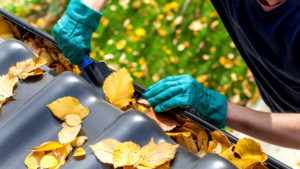
Cleaning your gutters can help protect your house from damage.
Steps you take this fall to maintain your home can keep you warm this winter and protect your property from loss.
As you take advantage of fall weather to work on projects around your home, pay special attention to these potential trouble spots:
- Clean out your gutters. Remove leaves and other debris from your gutters first by hand to get rid of the large particles, and then with a scraping tool and water hose before cold weather arrives. This helps to prevent overflows and ice damming. Ice dams are caused when snow melts on a heated part of the roof, then refreezes on a colder portion of the roof. This creates a dam and allows water to back up under the shingles, causing damage to insulation and interior ceilings or walls. The University of Minnesota Extension Service has more information about preventing ice dams.
- Make sure downspouts properly guide the water away from the home. Direct downspouts at least 6 feet from the foundation.
- Use door sweeps and caulk to block drafty areas of the home from the winter cold. Common areas for these are recess lighting areas, electrical outlets, door frames and windows.
- Have your furnace and chimney checked and cleaned annually. Change your furnace filter regularly; every three months is typical.
- Vacuum out your air ducts. Every few years, the air ducts should be vacuumed to help make sure that heated air passes through with no obstacles.
- Remove screens and put up storm windows. Add weatherstripping to seal out cold air, increasing your furnace’s efficiency.
- Reverse the circulation of your ceiling fans. As you fire up the furnace for the heating season, reverse your ceiling fan blades to rotate clockwise, creating an updraft that forces warm air down into the room. This can provide additional energy savings.
- Winterize your pipes. Adding insulation now can help prevent pipes from freezing later and causing breaks and water damage.
This loss control information is advisory only. The author assumes no responsibility for management or control of loss control activities. Not all exposures are identified in this article. For policy and coverage questions, contact your local, independent insurance agent.
